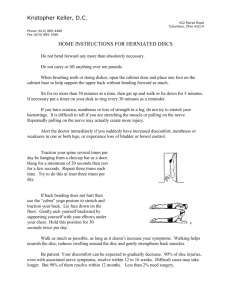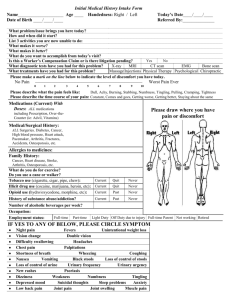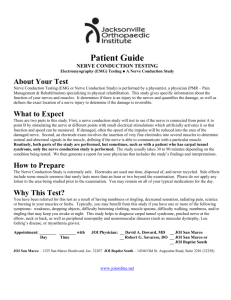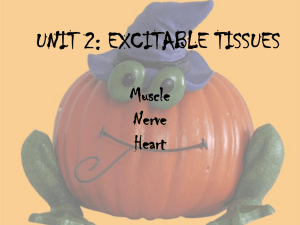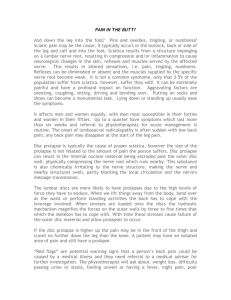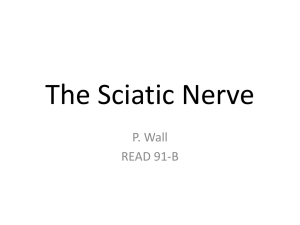File
advertisement
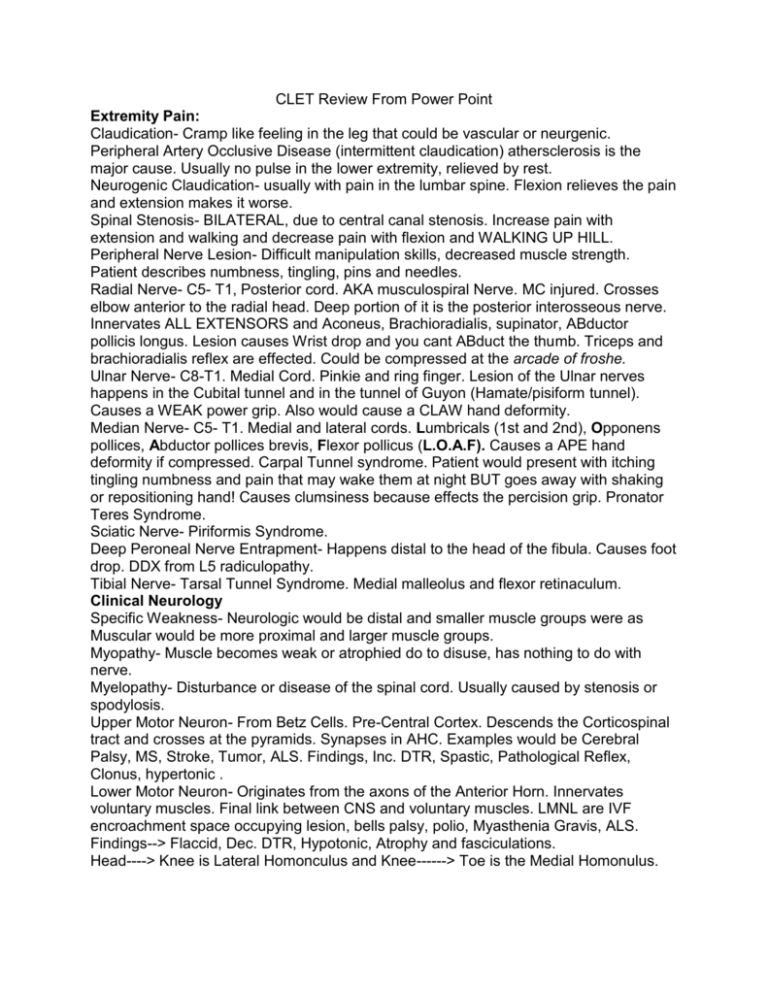
CLET Review From Power Point Extremity Pain: Claudication- Cramp like feeling in the leg that could be vascular or neurgenic. Peripheral Artery Occlusive Disease (intermittent claudication) athersclerosis is the major cause. Usually no pulse in the lower extremity, relieved by rest. Neurogenic Claudication- usually with pain in the lumbar spine. Flexion relieves the pain and extension makes it worse. Spinal Stenosis- BILATERAL, due to central canal stenosis. Increase pain with extension and walking and decrease pain with flexion and WALKING UP HILL. Peripheral Nerve Lesion- Difficult manipulation skills, decreased muscle strength. Patient describes numbness, tingling, pins and needles. Radial Nerve- C5- T1, Posterior cord. AKA musculospiral Nerve. MC injured. Crosses elbow anterior to the radial head. Deep portion of it is the posterior interosseous nerve. Innervates ALL EXTENSORS and Aconeus, Brachioradialis, supinator, ABductor pollicis longus. Lesion causes Wrist drop and you cant ABduct the thumb. Triceps and brachioradialis reflex are effected. Could be compressed at the arcade of froshe. Ulnar Nerve- C8-T1. Medial Cord. Pinkie and ring finger. Lesion of the Ulnar nerves happens in the Cubital tunnel and in the tunnel of Guyon (Hamate/pisiform tunnel). Causes a WEAK power grip. Also would cause a CLAW hand deformity. Median Nerve- C5- T1. Medial and lateral cords. Lumbricals (1st and 2nd), Opponens pollices, Abductor pollices brevis, Flexor pollicus (L.O.A.F). Causes a APE hand deformity if compressed. Carpal Tunnel syndrome. Patient would present with itching tingling numbness and pain that may wake them at night BUT goes away with shaking or repositioning hand! Causes clumsiness because effects the percision grip. Pronator Teres Syndrome. Sciatic Nerve- Piriformis Syndrome. Deep Peroneal Nerve Entrapment- Happens distal to the head of the fibula. Causes foot drop. DDX from L5 radiculopathy. Tibial Nerve- Tarsal Tunnel Syndrome. Medial malleolus and flexor retinaculum. Clinical Neurology Specific Weakness- Neurologic would be distal and smaller muscle groups were as Muscular would be more proximal and larger muscle groups. Myopathy- Muscle becomes weak or atrophied do to disuse, has nothing to do with nerve. Myelopathy- Disturbance or disease of the spinal cord. Usually caused by stenosis or spodylosis. Upper Motor Neuron- From Betz Cells. Pre-Central Cortex. Descends the Corticospinal tract and crosses at the pyramids. Synapses in AHC. Examples would be Cerebral Palsy, MS, Stroke, Tumor, ALS. Findings, Inc. DTR, Spastic, Pathological Reflex, Clonus, hypertonic . Lower Motor Neuron- Originates from the axons of the Anterior Horn. Innervates voluntary muscles. Final link between CNS and voluntary muscles. LMNL are IVF encroachment space occupying lesion, bells palsy, polio, Myasthenia Gravis, ALS. Findings--> Flaccid, Dec. DTR, Hypotonic, Atrophy and fasciculations. Head----> Knee is Lateral Homonculus and Knee------> Toe is the Medial Homonulus. Cerebellum- Co-Ordination of motor activity. Fine Motor Control. Stores Learned sequences. Dysfunction would cause the patient to have a rag doll appearence and seem to be inebriated and floppy. Cause hypotonia and disequillibrium. Causes Ataxia. Also will cause intention tremors, Dysmetria (pass pointing), Nystagmus, Dysdiadochokinesia, Dysarthria ( Slurred or scanning speech) Ataxia- Lack of coordination or clumsiness of voluntary movement (not the result of muscular weakness) due to the error of speed, force and direction of movement. Cerebellar Ataxia ( Motor Ataxia)- Patient unstable on there feet, drunken in appearance have a slap and wide gait. Cant stand with there feet together. Patient leans or staggers toward the side of the leasion. Basal Ganglia- Modulates and adjust tones of the motor system. RESTING TREMORS! Seen in Parkinsons which is degeneration of the substantia nigra of the basal ganglia. Tremor leaves with actions. Chorieform Movements--> Rapid abrupt jerky movements that are well coordinated but involuntary. Athetoid Movements--> Slow withering wormlike movements. Also will experience cogwheel rigidity and lead pipe rigidity, hypotonia and disturbances in postural reflexes (inability to recover balance quickly) Dorsal Columns- Ascending Tract, Carries vibration, position sense pressure and discriminatory touch. Vestibular Ataxia- Has inner ear problem is gravity dependent and is only seen when the patient stands or attempts to walk. Sensory Ataxia- Lesion in the propriception pathway, Diminished vibration sense and joint position. Parkinsons- Paralysis Agitans aka Shaking Paralysis. Degeneration of the substantia nigra and decreased dopamine production. Resting Tremors, Hypokinesia, Bradykinesia, hypohonia and micrographia. Also has a mask like facial expression and difficulty initiating voluntary movements. Syringomyelia- Idiopathic disease, lower cervical and upper thoracic region, headache and shoulder pain in a shawl like distribution. May develop horner syndrome. Tabes Dorsalis- Tertiary Syphillis loss of proprioception and vibratory sensation. Multiple Sclerosis- Younger Patient Dizziness, numbness, tingling, dipolpia, urinary sphincter dysfunction and weakness comes and goes. Demyelization of the spinal cord and white matter of the brain. Labs would be Increase protein in CSF and mild lymphocytosis. Optic Neuritis which is abrupt vision loss in one eye that is not self limiting ALS- Muscle weakness and cramping in the hand. Signs get progressively worse. Problems with chewing swallowing coughing and breathing. UMN and LMN lesions. Sensory remains normal. No management is known death within 2-2.5 years. Myasthenia Gravis- Young Female complains of double vision, difficulty swallowing, arm weakness and weak jaw muscles after CHEWING! Eyes are the first to be effected though. Auto antibodies block the receptors for ACH making them unavailable. Headaches Red Flags- “Worst HA of my life”, HA due to trauma, persistent HA, New HA in older patient, Nuchal Rigidity with fever----> Meningitis, w/o fever----> subarachnoid hemorrhage. Migraine with Aura- Classic Migraine. Unilateral throbbing headache, increase blind spot and flashing lights lasts 1-3 days. Was thought to be vascular and now thought to be neurogenic. Photo and phonophobia. Migraine w/o aura- Common Migraine. Severe headache but patient can continue ADL. No neurological findings. Tension HA- Frequent occurrence. Worse in afternoon or evening. OTC and NSAIDS help. Sub occipital or suborbital. Cervicogenic HA- Referral from soft tissue structures. Cluster HA- Middle Aged Male, Painful HA that is orbital in location. Usually last for 30 minutes. History of smoking and drinking. Neurologic HA- Sudden onset, progressive and dizziness or nausea maybe present. CN finding will be present requires immediate refereal. 5 D’s- Diplopia, Dizziness, Drop Attacks, Dysarthria, Dysphagia, Difficult Walking. 3 N’s - Nausea, Numbness and Nystagmus. If you suspect cerebral vascular compromise GET THAT MOFO OUT YOUR OFFICE AND CALL 911! Chest and Lung Pathology Normal breath sound is vesicular and that is the majority of the lung field. Bronchial--> High Pitch---> Expiration----> loud Vesicular ---> Low Pitch ---> Inspiration ---> Soft Bronchiovesicular---> Intermediat---> Exp=Ins---> Intermediate Adventitious Breath Sounds- Crackles. Fine are soft and high pitch and course is loud and low pitch Wheezes and Ronchi- Wheezes are hisses High pitched. Ronchi Low Pitch, Snoring. Chronic Bronchitis- Bronchi are inflammed and productive cough. Normal percussion (resonance) Consolidation- Alveoli are filled with blood or fluid. Percussion is dull and bronchial airsounds. Vocal resonance and tactile fremitus are involved. Atelectasis- Obstruction. Percussion reveals dullness breath sounds are absent. Asthma- Narrowing of the tracheobronchial tree. Hyper-resonance percussion. Wheezes are present. Vocal Resonance and tactile fremitus are both decreased. Costochondritis- Younger Patient, bilateral chest pain in nature usually ribs 2-5 and mid sternum pain. Teitze Syndrome- Woman over 50. Moderate to severe pain, unilateral in nature. Over exertion and coughing makes worse. Pleurisy- Sharp Pain in the chest related to coughing sneezing or positional in nature. Most noted with side bending or laying on involved side. Recent history of respiratory infection. Pulmonary embolism- Sudden chest pain after pain in the calf. Severe and similiar to MI. Angina Pectoralis- Squeezing and pressure in the chest. Most noted after exertion. Pain last up to 30 minutes decreases with rest. MI- History of Angina previously, nitroglycerine doesnt work. Lasts over 30 min. Intercostal Neuritis- Unilateral Chest Pain. Esophageal- Substernal pain with laying down, dysphagia or heart burn. S1- AV closure. Mitral area. Lower pitched and longer duration then S2 S2- Semilunar valve closing. Aortic. Higher pitched and shorter then S1. S3- Not normal in adults if heard its immediately after S2. Indicates left ventricular fail. Known as a gallop. S4- Heard immediatly before S1. May indicate MI Chronic Abdominal Pain- Empty stomach----> Ulcer; Full Stomach----> Reflux Appendicitis- Anorexia followed by pain. Nausea and Vomiting, RLQ pain. Cough and jarring makes pain worse. Rovsings or Psoas sign. Also may have low grade fever (<102) Cholecystitis- Pain after eating a fatty meal. Obese or patients that lost significant weight. Murphys sign would be positive. RUQ rebound tenderness and pain reffered to the scapula. Urethral stones- MC is calcium oxalate, usually due to dehydration or excessive intake of calcium oxalate or protein. Patient will always move with pain and sometimes have hematouria. Pancreatitis- Usually a alcoholic with a sudden onset of pain! Obstruction of the ampulla of vader by a gallstone. Patient will come in with a mild fever and NO BOWEL SOUNDS. Peptic Ulcer- Epigastric Burning that wakes the patient from sleep. Antacid and OTC can provide some relief. Gastric--> NSAIDS used; Duodenal--> H. Pylori. GERD- Epigastric Pain in a obese patient or preggo after eating a large meal or laying down. Decrease of the esophageal sphincter in tone Numbness, Tingling and Pain Parasthesia- Spontaneous abnormal sensations that is described as tingling, pins and needles and crawling. Dysesthesia- sometime refered as hyperpathia, when a normal pressure causes pain to the patient. Elevated threshold to stimuli (hypersthesia) Pain and Temp is conveyed by the free nerve endings and lateral spinothalamic tract. Propriception is perceived by the dorsal column by muscle spindles and GTO’s. Meissners is light touch and pressure, Merkles is deep touch and pressure, pacinian is vibration (Those are all known as mechanoreceptors) Anterior spinothalamic- DEEP touch and pressure Joint Position Sense- 1 degree in fingers and 2 degrees in toes. Do with the patients eyes opened then closed. Perceived by dorsal column (Proprioception). Work distal to proximal. Two Point Discrimination- Somatosensory, most sensitive in finger tips and less in dorsum of hand. True Numbness- Comes with clinical and neurological findings, effects pain and temp Perceived- no neurological findings are present. TOS- Posture effects symptoms, pallor, pain, temperature and parasthesia. Traction trauma and postural changes cause this. Most common in LOWER brachial plexus (Ulnar Nerve). Usually effects C8 and T1 90% of the time. Orthopedic test for TOS- Roos/E.A.S.T is the most reliable and test for all types. Adsons test for constriction by the anterior scalene or cervical rib and so does edens aka costoclavicular. Wrights test aka hyperabduction test is compression of the axillary artery by pec minor or coracoid. Upper Crossed syndrome- Muscles Tight---> Pec Major/Minor, Upper Trap, Levator Scap and SCM. Weakend muscles---> Lower and Middle Trap, Serratus Ant, and Rhomboid Minor and Major. Lower Crossed Syndrome- Tightened Mus.----> Iliopsoas, Rectus Femoris, TFL, Erector Spinae, and Quadratus Lumborum. Lengthened Mus.---> Abs and Glutes. CNS- Ususally presents BILATERALLY, if spotty think MS. Metabolic- Bilateral and Distal. No Motor Findings are present. Plexopathies- Cervical---> Brachial Plexus or TOS. Lumbosacral--> Pelvic Surgery, diabetes, or direct compression. Reffered Pain Syndromes Fibromyalgia- Clinical Syndrome NOT disease. Fatigue and tenderness. No known cause. Patients must exhibit 11 of the 18 tender points. A tender point is PAINFUL and not just tender with 4kg of pressure. MC in woman. Dermatonal- Arises from NR. Very Localized. Sharp Shooting, tingling, and numbness. Scleratomal- Crosses dermatonal patterns. Normal muscles strength, reflex and sensory. Usually referred from facet. Does NOT cross the GH joint, does not cross knee. Deep dull ache. Visceral Pain- Overlapping symptoms. Provide information about homeostasis. Usually central in nature. Stays in the area of the embryological location of the organ. Main Stimuli in visceral conditions is distention, inflammation and ischemia. Osseous Pain- BONE usually deep and boring and worse at night. Common Musculoskeletal Conditions Tendon Injury- Pain is elicited on active ROM and contraction of the muscle belly. Bursa- There are standard bursa on most individuals but there may also be adventitious bursae that are brought on by repetitive stresses and friction. Ligament- Excessive force on opposite side (valgus or varus) Orthopedic Test- Done to reproduce the patients complaint, reveal laxity, demonstrate weakness, and demonstrate restriction. Scleratogenous Pain- Pain derived from connective tissue. In cervical doesnt cross the GH jt, and in the lumber does NOT cross the knee jt. Pain will be sharp at the site of lesion and dull achey referred pain. Usually patient cant describe pain. Dermatogenous Pain- Pain that is derived from the Nerve root. Radicular in nature. Patient can pin point where the pain is. Pain tend to be sharp or shooting. Radiculopathy- Pathology of the nerve Root. Pain follows dermatomal pattern. Neuropathy- Pathology of any nerve usually refers peripheral nerve. Myotagenous pain- Pain derived from muscle. Pain is local and refers (fibromyalgia is local and doesnt refer). This pain is refered to myofascial pain. These will exhibit trigger points as well and the muscles around the area will be ropey or taunt. Will Have “Jump Sign” or Local twitch response. Medial disc protrusion- Pain on right patient will have pain when leaning to the left (antalgic lean would be to the right) Disc Disease Major stresses that the disc goes through are axial compression, shearing, bending and twisting. Innervation- Sinuvertebral Nerve--> branch of the ventral ramus and the sympathetic trunk. Innervates outer half of the IVD, PLL, Dura Mater, and Spinal canal Vessels Protrusion/Bulge- Bulges outward through the tear in the AF but does not escape the outer AF or the PLL. Pain is worse in the morning due to inhibition. Extrusion- Nuclear material remains attached but escapes the AF or PLL. Posteriolateral in nature. Higher pain levels and leg pain will be present. Sequestration- The migrating disc material escapes the disc all together and becomes a free floating fragment. May migrate up and down canal. Cervical Disc- Nucleus Pulposes is no more then 25% of the disc. Significant disc herniations can lead to leg pain (myelopathy) Intradiscal pressure- Laying with pillow under leg- 35kg, standing- 100kg, standing and leaning forward- 150kg, bending to lift box- 220kg, sitting- 140kg, sitting lean forward185kg, sitting and leaning to carrying 275kg.
